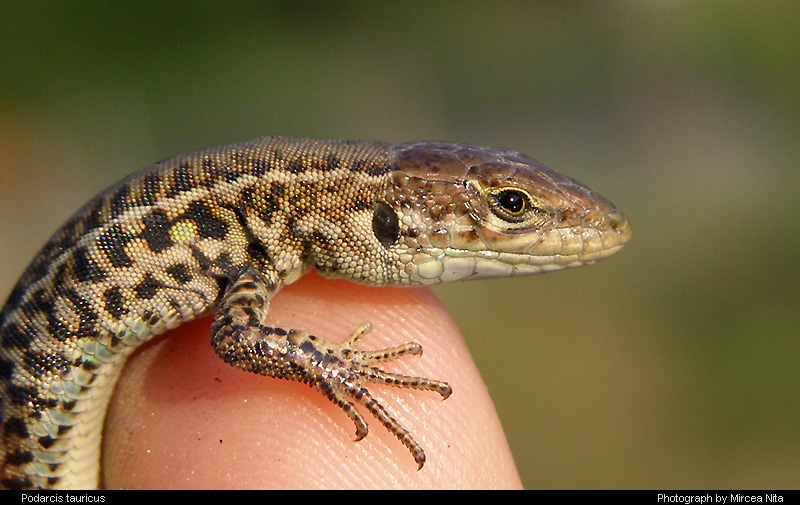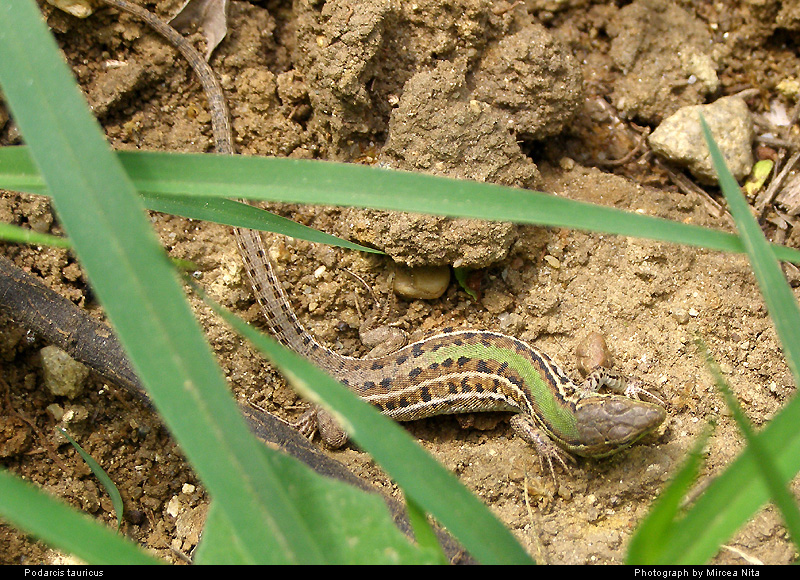| |



Podarcis tauricus
Balkan wall lizard - Podarcis tauricus - Pallas, 1814
Description:
Total length is 18 to 20 cm and the tail can sometimes be twice body length. The head is rather small with the snout obtusely pointed and a toothed collar formed of 8 to 12 plates (usually 9 to 11).
The number of scales across the body is between 42 and 62. The plates of the belly are arranged in 6, rarely 8 longitudinal and 25 to 32 transverse series (25 to 29 in males, 25 to 32 in females).
Preanal plate has 2 or 3 semicircles of small plates or scales.
In the typical form (P.t. tauricus) there are 14 to 20 femoral pores (usually 15 to19) and 15 to25 (usually 15 to 19) in specimens from Greece and Ionian Islands (var. ionicus and thasopulae).
Caudal scales are more or less obtusely pointed behind, the upper scales being strongly keeled and the lower smooth or feebly keeled.
The coloration is green on back, head and neck (in dry season is more olive or brown) and brown or dark-grey on the sides of the body, with a more or less distinct light stripe along each side of the back, bordered towards the centre of back by a brown area overlaid by black blotches. Above the shoulder has a more or less distinct blue spots.
The belly is white or cream in females and yellowish or orange in males.
On each side of the posterior part of the body and on the base of the tail a pale brown color forms spots or a band. Occasionally it has small black spots on the back. The tail is brownish grey with light spots.
Biology:
In April - May (depending upon the weather conditions) the Balkan wall lizard emerges from hibernation when mating takes places. The eggs (1 to 10 in number) are laid in late May or June and buried in an underground gallery. Hatchlings emerge in August.
Their diet consists mainly in invertebrates like insects and spiders. Having a lot of enemies like raptors, a typical feature of lizards displayed by them is the dropping of the tail when captured in order to escape predators, the tail growing up again.
It moves very fast when escaping predators, taking refuge in holes in ground, under stones or bushy plants, etc. at first sign of danger.
Habitat:
Being a largely terrestrial species their usual habitats include: meadows, steppes, grassland, field borders, rural gardens, sparsely vegetated dunes by the sea and road and path verges and is typically found on flattish dry ground with at least some covering of grass or other low vegetation.
It is mainly a lowland species found from sea level up to2350 m in southern Greece.
Distribution:
Range (on countries): Albania; Bulgaria; Greece; Hungary; the former Yugoslav Republic of Macedonia; Moldova; Romania; Serbia; Turkey; Ukraine.
Scientific name: Podarcis tauricus
Common name: Balkan wall lizard
Taxonomy:
Species: Podarcis tauricus
Subspecies: Podarcis tauricus tauricus (Pallas, 1814)
Podarcis tauricus ionicus (Lehrs, 1902)
Podarcis tauricus thasopulae (Kattinger, 1942)
IUCN Status: LC (Least Concern)
"Podarcis tauricus is listed as Least Concern in view of its wide distribution, tolerance of a broad range of habitats, presumed large population, and because it is unlikely to be declining fast enough to qualify for listing in a more threatened category.
This species is listed on Appendix II of the Bern Convention, and on Annex IV of the European Union Habitats Directive, and is protected by national legislation in parts of its range. It occurs in a number of protected areas.
This species is locally threatened in parts of its range by habitat loss through agricultural intensification and pollution (largely from the use of agrochemicals), but overall it is not at significant risk."*
References:
Arnold, E.N. 2003. Reptiles and amphibians of Europe. Princeton University Press., Princeton and Oxford;
Arnold, E. N., Arribas, O. and Carranza, S. 2007. Systematics of the Palaearctic and Oriental lizard tribe Lacertini (Squamata: Lacertidae: Lacertinae), with descriptions of eight new genera. Zootaxa 1430: 1-86.
Boulenger, G.A. 1917. Descriptions of new lizards of the family Lacertidae. Ann. Mag. nat. Hist. (8) 19: 277-279;
Clark, R. (1999) - herpetofauna of Thassos, North Aegaen Sea, Greece. - Bitish HerpetoloSical Sociery Bulletin, 66: 14-18;
Covaciu-Marcov S.-D.; Ghira, I.; Cicort-Lucaciu A.-St., Sas I.; Strugariu, A. & Bogdan H. V. 2006. Contributions to knowledge regarding the geographical distribution of the herpetofauna of Dobrudja, Romania. North-Western Journal of Zoology 2 (2): 88-125;
Covaciu-Marcov, S.D., Cicort-Lucaciu, A.S., Dobre, F., Feren?i, S., Birceanu, M., Mihu?, R. & Str 2009. The herpetofauna of the Jiului Gorge National Park, Romania. North-Western Journal of Zoology 5 (Suppl. 1): 1-78;
Council of Europe. 2003. Convention on the Conservation of European Wildlife and Natural Habitats. Group of experts on the conservation of Amphibians and Reptiles. Mälmo (Sweden), 26-27 September 2003. Report T-PVS (2003) 18;
Fuhn, I. & S. Vancea, 1961: Fauna Republicii Romāne, 14. Reptilia (Testoase, Sopārle, Serpi). Bucuresti;
Gasc, J.-P., A. Cabela, J. Crnobrnja-Isailovic, D. Dolmen, K. Grossenbacher, P. Haffner, J. Lescure, H. Martens, J.P. Martinez-Rica, H. Maurin, M.E. Oliveira, T.S. Sofianidou, M. Veith & A. Zuiderwijk, 1997: Atlas of Amphibians and Reptiles in Europe. - Societas Europaea Herpetologica und Muséum National d'Historie Naturelle (IEGB/SPN), Paris;
Joger, U.; Fritz, U.; Guicking, D.; Kalyabina-Hauf, S.; Nagy, Z.T. & Wink, M. 2007. Phylogeography of western Palaearctic reptiles - Spatial and temporal speciation patterns. Zoologischer Anzeiger 246: 293-313;
*IUCN 2011. IUCN Red List of Threatened Species. Version 2011.2. ;
Ljubisavljevic, Katarina; Dzukic, Georg ; Kalezic , Milos L. 2010 - Female reproductive characteristics of the Balkan wall lizard (Podarcis taurica) in the northwestern periphery of its range - Central European Journal of Biology p.391-395;
Szczerbak, N.N. 2003. Guide to the Reptiles of the Eastern Palearctic. Krieger, Malabar, FL, 260 pp;
Sos, T. 2008. Review of recent taxonomic and nomenclatural changes in European Amphibia and Reptilia related to Romanian herpetofauna. Herpetologica Romanica 2: 61-91.
|
|

